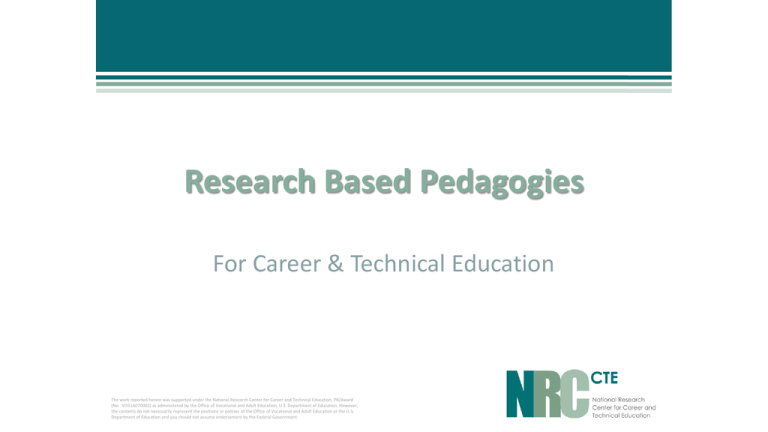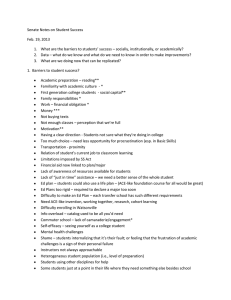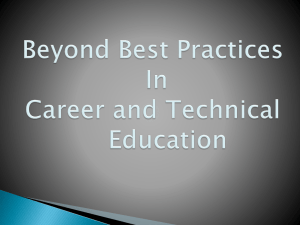Research Based Pedagogies For Career & Technical Education
advertisement

Research Based Pedagogies For Career & Technical Education The work reported herein was supported under the National Research Center for Career and Technical Education, PR/Award (No. VO51A070003) as administered by the Office of Vocational and Adult Education, U.S. Department of Education. However, the contents do not necessarily represent the positions or policies of the Office of Vocational and Adult Education or the U.S. Department of Education and you should not assume endorsement by the Federal Government. Context: Quality Career Pathways Systems Change •Align the College & Career Ready System Components Program Improvement •Bring existing programs to standard & add new programs Instructional Delivery •Ensure all CTE faculty are highly skilled in pedagogy and in their professions Rigor = More A narrow curriculum High school has become the new middle school Where Have We Been: 30 Years of “Reform” Solution? Pile on more academics Since the mid-1980s we have: Added the equivalent of one full year of core academics (math, science, language arts) to high school graduation requirements. • (NAEP) Reading scores have not improved or significantly declined* • (NAEP) Science scores have not improved or significantly declined* • (NAEP) math scores have remained relatively unchanged *Depends on the starting and ending timeframe Taking more math is no guarantee (ACT College Ready Math=22) • Only 17% of 2013* HS students who took Alg I, II & Geometry or less scored a 22 (ACT Benchmark for CCR) on the ACT exam. (X=17.4)1 • Adding Trig (or other math) increases to the average score to 19.9; 43% are CCR1 • Not until calculus is added, does the average score exceed 22; 58% are CCR– 5 years of high school math. • Other, non-identified combinations of four years of math also do well (x=23.6) 1. ACT, Inc (2013) ACT Profile Report: Graduating Class of 2013. 54% of US seniors took exam College & Career Ready Math NCEE, 2013 NRCCTE, 2013 • Math needed is • Math associated with an ACT score of mostly middle school 22 is mostly middle school math, • Alg II is not a Algebra I and some geometry. prerequisite for CC • Math associated with middle skill job success or most employment tests is careers higher than that • College reading required for an ACT requires 11th/12th score of 22 but still grade skills found in middle school • Students enter CC math, Algebra I and weak in needed math some geometry and reading skills Did you know…. …nationally, 28% of CTE teachers are alternatively certified? (Ruhland, 2002) …in a HSTW survey, 75% of CTE teachers in 30 states reported being alternatively certified (SREB, 2007) …25% of all teachers leave the profession in the first three years (USDOE, 2006) What is Teaching to Lead (T2L) • Evidence based teacher induction for new, alternatively certified CTE teachers • Adopted from a 5-year R&D study conducted by the NRCCTE/SREB: – Improving the Quality of Career and Technical Alternative Teacher Preparation • Initially a collaborative effort of State of Kentucky, Jefferson County Public Schools and the NRCCTE. • Piloted in 2013-2014; expanding our delivery of PD since then Teaching to Lead (Original) Goals • Increase new teacher efficacy • Increase CTE teacher retention Teaching to Lead: The Model • Systematic, developmental approach to support new teachers in their first year • 10 days of PD spans the first year • 4 field-tested content modules • Module content delivered in 3 phases • School-based coaching after each phase T2L Professional Development Content (From the Study) Instructional Planning: Create short-term and long-term standards-based instructional plans based on the varying learning needs of students. Instructional Strategies: Use instructional strategies that actively engage students in learning and encourage the development of problem-solving, critical thinking, and teamwork skills. Teacher Competence Classroom Assessment: Classroom Management: Use formal and informal Create a learning environment assessment strategies to evaluate that encourages student student progress toward learning motivation, positive behavior, and goals and provide feedback to collaborative social interaction. improve student learning. Teacher Reflection: Reflect, both individually and collaboratively, on the effects of instruction and use the reflective process to continually improve instructional practice. CTE Teacher Preparation Project High Quality CTE is delivered through: Project based learning Classroom instruction Contextualized learning Labs & Shops Job shadowing Internships Work based learningWBL School-based enterprise Cooperative education Apprenticeships Leadership development CTSOs Professional development Service/social engagement Competitive events What kinds of knowledge and skills are taught in CTE? CTE Teacher Preparation Project 3 Skill Sets (Developed through HQ CTE) Occupational Expression of Academics Mathematics Science Communications Personal Effectiveness & Foundational Workforce Competence SCANS 21st Century Skills “Soft” Skills College & Career Ready Technical Job specific skills valued by employers Technical Knowledge and Skills Description Examples State or local career/technical standards or competencies verified by business and industry National industry standards Business Management: Identify potential business threats and opportunities for protecting a business’s financial well-being. Health Sciences: Explain infection control practices and procedures. CTE Teacher Preparation Project 15 Occupational Expression of Academic Knowledge and Skills Description Examples • State academic • Read, comprehend, and standards synthesize information from – Reading a wide range of sources within the technical field. – Mathematics – Science • Demonstrate mathematical • National standards— reasoning and procedures, Common Core State and an understanding of major mathematics Standards concepts that underlie a • Industry “academic” career field. standards/needs CTE Teacher Preparation Project Mfg tell us most adults cannot pass a 4th grade math test Non-Cognitive Deal with setbacks Stay on track Not easily distracted Consistency Hard worker Persistence ‘Stick-to-it tivess’ Diligence Employability Duckworth, 2011 “Grit” Teamwork Oral & written skills Professionalism Ethics Creativity Problem solving Systems knowledge Responsibility SCANS, 21st Century The Research: Observed Progress - Teaching Practice Knowledge of Content Standards and Learning Targets Knowledge of Students Lesson Sequence and Pacing Intellectually Challenging Questioning Presenting Information Project/Problem-Based Learning Phase 3 Cooperative Learning Phase 2 Embedded Literacy Phase 1 Embedded Numeracy Use of Assessment Tools Classroom and Lab Space Personalization Clasroom Rules and Norms Classroom Procedures Interventions and Consequences Not Yet Basic Proficient Advanced Can CTE Improve Academic Skills? • Mathematics • Literacy • Science What We Learned: Experimental Test of Math Integration • Students in the experimental classes scored significantly higher on Terra Nova and Accuplacer • The effect: 71st percentile & 67th percentile • No negative effect on technical skills • 11% of class time devoted to enhanced math lessons • Significant improvement from both approaches • Teachers with twoyears experience in method had greater effect Focus on Reading Science Integration: Experimental Studies • Overall, no effect • Significant effect for nonwhite males and females NRCCTE • • NRCCTE Worked on a long term project Project was based a real world (authentic) problem Brandon Busteed, Executive Director of Gallup Education Presentation at the NASDCTEc October 21, 2014 What is a CTE project? NRCCTE Engages students in learning knowledge and skills through extended inquiry process Structured around complex, authentic questions and carefully designed products and tasks What is PBL project-based learning? An instructional approach in which the content of a course is organized around projects central to the course content Students learn through engagement with a series of authentic projects Students present their projects to an authentic audience CTE Teacher Preparation Project 26 Factual learning equivalent or superior Increase in transfer of learning More flexible, useful kind of knowledge Engagement in exploration and thought Positive changes in motivation, attitude toward learning, thinking skills and problem solving abilities Better match to learning style, particularly for students who have struggled in school Source: Teaching for Meaningful Learning: A Review of Research on Inquiry-Based and Cooperative Learning by Brigid Barron and Linda Darling-Hammond NRCCTE CTE Teacher Preparation Project Activities vs. Projects Activities are: NRCCTE Learning experiences that enable students to learn knowledge, procedures and/or skills Designed with a predictable outcome Means to an end, not an end in themselves Designed to last from 1 to 3 class periods Projects are: Designed around authentic problems or tasks Structured so that students are involved in extended inquiry, productive struggle Of one or more weeks in duration CTE Teacher Preparation Project 28 You are a (insert a real-world role). You are faced with (insert a problem). You must (insert what must be done to solve the problem). Once you have decided on a course of action, you will (insert an opportunity for presentation to an authentic audience). NRCCTE CTE Teacher Preparation Project (Scenario) You are a member of a venture capital group who will propose a new international business. Prepare a written proposal (30 pages) for the venture, describing the type of business, proposed country for trade, rationale for selecting the country, identifications of existing trade barriers, and a thorough analysis of the international business situation (economic and political systems, culture, and trade area). The proposal must describe the planned business operation (organization, product/services, and strategies) as well as planned financing, including income and expenses. In addition to the written proposal, give a 15-minute presentation about the proposal, selling the idea to potential investors. Source: DECA Competitive Event NRCCTE Designing Effective Instructional Plans (Scenario) You are a construction manager. Your crew will be using explosives to clear fallen rocks from a roadway, a task with many inherent risks—flying rock, premature detonation, vibration, air-overpressure and environmental pollution. Although the blaster is responsible for setting and detonating the explosives, safety is the responsibility of the construction manager and every member of the construction crew. Research and read the appropriate set of OSHA regulations, understand the technical information it contains, and extrapolate the most important information. Plan a “toolbox talk” for the construction crew to effectively convey the safety instructions and reinforce their awareness of the safety issues at hand. Source: American Diploma Project Sample Reading Task NRCCTE CTE Teacher Preparation Project NRCCTE You are a web site designer hired by a school textbook company to create an interactive website on the content of the textbook. The company has developed support materials for students using the textbook, such as enrichment ideas, extra practice, checkpoint quizzes, and video clips of instructors explaining difficult concepts. Create a Web page for students to access these resources and present your layout to the company for their approval. CTE Teacher Preparation Project NRCCTE You are a designer for a company that manufacturers staircases for the home building industry. Based on a customer’s description, develop specifications for the desired stairway, including the width, the span to be joined by steps from bottom to top and the style of stairs needed. Use computer software to draw the plans and direct the appropriate machinery to cut the parts. Assemble the parts, measure the finished staircase for accuracy and prepare it for delivery to the customer. CTE Teacher Preparation Project As a chef at a local eatery, the owner has asked you to develop several menu items that would appeal to customers who are health-conscious. Create several recipe ideas, determine their nutrition information, and test them on potential clients. Develop a set of criteria for your final selections for the menu. Present your final recommendations to the restaurant owner, explaining how each food meets the criteria you have identified. NRCCTE Designing Effective Instructional Plans Built on authentic, work-based problems of practice Externships (Team) Integrates mathematics and literacy Embedded industry problem solving approaches Cohort model NRCCTE NRCCTE Bridgeland, et al - Gates Foundation Report, 2005 Work Based Learning Underutilized Pedagogy Work Based Learning: Pedagogy • Learning plans guide the process; monitored by teacher and supervisor, the plan should: – Provide for exposure to communities of practice – Provide for rotation among positions, tasks – Provide for reflection and thoughtful connection to classroom learning (e.g., journaling) • Align learning with established standards – industry and academic • Student performance is documented and assessed with input from employer Workbased Learning WBL Approach • • • • • • • • Labs Shops Job shadowing Internships School-based enterprise Cooperative education Apprenticeships Service Learning Potential Learning • All aspects of an industrycurriculum integration • Relevance of academics • SCANS/21st Century Skills • Skills leading to industry certifications • Career development WBL: Everywhere but in the U.S. • The % of youth in VET ranges from 5% (Ireland) to 80% (Czech Republic). • More than 50% youth in VET: Austria, Belgium, Finland, Switzerland, Australia, Germany, Sweden, Denmark and others. • Japan, United Kingdom, France, Korea and others exceed 20% • The U.S. doesn’t make the list! Learning for jobs (OECD, 2010) The Value of WBL Nations enrolling a large proportion of upper-secondary students in vocational programs that include heavy does of WBL have significantly higher: • school attendance rates • higher upper-secondary completion rates • college attendance Bishop & Mane, 2004 Skills Learned in the Workplace: Not in the Classroom • Non-Cognitive • • • • • • • • Deal with setbacks Stay on track Not easily distracted Consistency Hard worker Persistence ‘Stick-to-it tivess’ Diligence Duckworth, 2011 “Grit” • • • • • • • • • Employability Teamwork Oral & written skills Professionalism Ethics Creativity Problem solving Systems knowledge Responsibility SCANS, 21st Century A Developmental Approach to Improving Instructional Delivery Teaching to Lead Authentic Literacy Math-In CTE PBL for Career Pathways Science InCTE The Curriculum for CTE Professionals Questions? Shameless Promotion . . . VISIT OUR WEBSITE OR SEND ME A NOTE www.nrccte.org james.stone@nrccte.org

